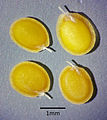Calyx stone herb
| Calyx stone herb | ||||||||||||
|---|---|---|---|---|---|---|---|---|---|---|---|---|

Calyx stone herb ( Alyssum alyssoides ) |
||||||||||||
| Systematics | ||||||||||||
|
||||||||||||
| Scientific name | ||||||||||||
| Alyssum alyssoides | ||||||||||||
| ( L. ) L. |
The calyx stone herb ( Alyssum alyssoides ) is a species of the genus stone herbs ( Alyssum ) within the cruciferous family (Brassicaceae).
description
Vegetative characteristics
The calyx stone herb grows as an annual herbaceous plant and reaches a stature height of about 8 to 25 centimeters. The root is thin and spindle-shaped. The stem grows upright or ascending and usually has numerous ascending branches at the base that are as long or longer than the main shoot.
The leaves are lanceolate with a length of 5 to 30 millimeters and the lower ones are obovate. The underside of the leaf is colored whitish by star hairs and the upper side is colored light gray-green by loose hairs.
Generative characteristics
The flowering time is mainly from April to September. The terminal, racemose inflorescence contains 20 to 50 flowers. The flower stalks reach a length of 2 to 5 millimeters and are almost horizontally protruding.
The hermaphrodite flowers are fourfold. The approximately 2 to 3 millimeter long sepals remain on the plant until the fruit is ripe. The four pale, sulfur-yellow petals are about 2.5 to 4 millimeters long, slightly broadened at the tip, truncated to edged and discolored at the end of the anthesis . The longer stamens have no appendages, the shorter ones have a bristle on both sides. The stylus has a length of 0.3 to 0.5 millimeters.
The star-haired pods are almost round with a length of 3 to 4.5 millimeters and have bulbous flaps.
The number of chromosomes is 2n = 32.
ecology
The calyx stone herb is a therophyte .
From an ecological point of view, these are tiny pale yellow "pollen disc flowers" without nectar glands. There is mainly spontaneous self-pollination in that the stamens curve towards the stigma before blooming.
The seeds spread through stronger winds.
Occurrence
Alyssum alyssoides occurs in southern, central and eastern Europe . It can be found in the Middle East and northwestern Africa. It is a sub-Mediterranean floral element . Alyssum alyssoides occurs only regionally in Central Europe.
In Switzerland, Alyssum alyssoides is common. The calyx stone herb occurs in Germany in the central and north-eastern area scattered to widespread; in the north-west and south of the Danube it is rare or absent. In Austria the calyx stone herb occurs absent-mindedly or rarely in all federal states. It is considered endangered in the western Alps and in the northern and southeastern Alpine foothills.
The calyx stone herb thrives best on warm, open and often chalky soils . It grows in dry grass communities . Alyssum alyssoides is a character species of the Alysso-Sedetum in Central Europe , but is also found in other plant communities of the Sedo-Scleranthetea class.
Taxonomy
The first publication took place in 1753 under the name ( Basionym ) Clypeola alyssoides by Carl von Linné . In 1759 Linnaeus published the accepted name Alyssum alyssoides (L.) L. Another synonym for Alyssum alyssoides (L.) L. is Alyssum calycinum L. The specific epithet alyssoides means stone herb-like.
Common names
Other common names for the calyx stone herb, some of which are only used regionally, are or were: Mählweiß ( Austria ), tortoiseshell and stone herb.
photos
Ripe pod with star hair indument
Individual evidence
- ↑ a b Erich Oberdorfer : Plant-sociological excursion flora for Germany and neighboring areas. 8th edition. Verlag Eugen Ulmer, Stuttgart 2001, ISBN 3-8001-3131-5 , page 454.
- ^ Manfred A. Fischer, Karl Oswald, Wolfgang Adler: Excursion flora for Austria, Liechtenstein and South Tyrol . 3rd, improved edition. Province of Upper Austria, Biology Center of the Upper Austrian State Museums, Linz 2008, ISBN 978-3-85474-187-9 , p. 644 .
- ^ Carl Jessen : The German folk names of plants , published by Philipp Cohen Hanover 1882, page 23.
literature
- Henning Haeupler, Thomas Muer: picture atlas of the fern and flowering plants of Germany . Ed .: Federal Agency for Nature Conservation (= The fern and flowering plants of Germany . Volume 2 ). Eugen Ulmer, Stuttgart (Hohenheim) 2000, ISBN 3-8001-3364-4 .
- Wolfgang Adler, Karl Oswald, Raimund Fischer: Excursion flora of Austria . Ed .: Manfred A. Fischer. Eugen Ulmer, Stuttgart / Vienna 1994, ISBN 3-8001-3461-6 .
- Christian Heitz: School and excursion flora for Switzerland. Taking into account the border areas. Identification book for wild growing vascular plants . Founded by August Binz. 18th completely revised and expanded edition. Schwabe & Co., Basel 1986, ISBN 3-7965-0832-4 .
- Erich Oberdorfer : Plant-sociological excursion flora . With the collaboration of Theo Müller. 6th, revised and expanded edition. Eugen Ulmer, Stuttgart (Hohenheim) 1990, ISBN 3-8001-3454-3 .
- Konrad von Weihe (ed.): Illustrated flora. Germany and neighboring areas. Vascular cryptogams and flowering plants . Founded by August Garcke. 23rd edition. Paul Parey, Berlin / Hamburg 1972, ISBN 3-489-68034-0 .
- Ruprecht Düll , Herfried Kutzelnigg : Pocket dictionary of plants in Germany and neighboring countries. The most common Central European species in portrait . 7th, corrected and enlarged edition. Quelle & Meyer, Wiebelsheim 2011, ISBN 978-3-494-01424-1 .
Web links
- Alyssum alyssoides (L.) L., calyx stone herb. In: FloraWeb.de.
- Calyx stone herb . In: BiolFlor, the database of biological-ecological characteristics of the flora of Germany.
- Alyssum alyssoides (L.) L. In: Info Flora , the national data and information center for Swiss flora . Retrieved October 26, 2015.
- Distribution in the northern hemisphere according to: Eric Hultén , Magnus Fries: Atlas of North European vascular plants 1986, ISBN 3-87429-263-0 .
- Thomas Meyer: Data sheet with identification key and photos at Flora-de: Flora von Deutschland (old name of the website: Flowers in Swabia ).
- Günther Blaich: data sheet with photos.
- Gerhard Nitter: Profile with photos.






